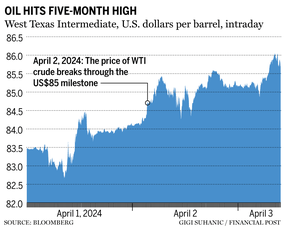Rising oil prices may affect timing of Bank of Canada rate cuts ...
Policymakers could find high energy prices concerning
Get the latest from Naimul Karim straight to your inbox

Published Apr 03, 2024 • Last updated 31 minutes ago • 3 minute read
Oil prices reached their highest levels in five months this week, and economists say that could make the Bank of Canada a “little concerned” as it figures out the right time to cut interest rates.
Fuelled by cuts in oil production by the Organization of Petroleum Exporting Countries (OPEC), resilience from major economies and escalating conflicts in the Middle East, West Texas Intermediate crude futures rose above US$85 on Tuesday, hitting the highest level since October.
THIS CONTENT IS RESERVED FOR SUBSCRIBERS ONLY
Subscribe now to read the latest news in your city and across Canada.
Exclusive articles from Barbara Shecter, Joe O'Connor, Gabriel Friedman, Victoria Wells and others.Daily content from Financial Times, the world's leading global business publication.Unlimited online access to read articles from Financial Post, National Post and 15 news sites across Canada with one account.National Post ePaper, an electronic replica of the print edition to view on any device, share and comment on.Daily puzzles, including the New York Times Crossword.SUBSCRIBE TO UNLOCK MORE ARTICLES

Subscribe now to read the latest news in your city and across Canada.
Exclusive articles from Barbara Shecter, Joe O'Connor, Gabriel Friedman, Victoria Wells and others.Daily content from Financial Times, the world's leading global business publication.Unlimited online access to read articles from Financial Post, National Post and 15 news sites across Canada with one account.National Post ePaper, an electronic replica of the print edition to view on any device, share and comment on.Daily puzzles, including the New York Times Crossword.REGISTER / SIGN IN TO UNLOCK MORE ARTICLES
Create an account or sign in to continue with your reading experience.
Access articles from across Canada with one account.Share your thoughts and join the conversation in the comments.Enjoy additional articles per month.Get email updates from your favourite authors.or
Article content
Article content
“I think it’s something that could frustrate the Bank of Canada from cutting rates or cutting them heavily,” Douglas Porter, chief economist at the Bank of Montreal, said. “They will be a little bit concerned. There obviously are a lot of factors that drive inflation … but energy prices and headline inflation can play a pretty big role, ultimately, in terms of what the bank decides.

Several economists expect the Bank of Canada to announce its first cut in interest rates in mid-2024. But those predictions could change with oil prices following an upward trajectory in the past month and reaching their highest point in five months on Tuesday following Israel’s airstrike on an Iranian embassy in Syria.
The rise in oil prices is not extreme — there were bigger price bumps when Russia began its war against Ukraine, for instance — but the longer it remains at this point, the more problematic the situation will become for the Bank of Canada, Porter said.
“Oil prices are above where we expected them to be,” he said. “It definitely puts a question mark over the whole prospect of Bank of Canada cuts if oil prices remain under sustained pressure.”
By signing up you consent to receive the above newsletter from Postmedia Network Inc.
Article content
Article content
However, the BMO economist also said it’s “fairly rare” for the bank to specifically cite oil prices as a driver of policy, although it’s not unheard of. For example, the Bank of Canada cut interest rates in 2015 due to falling oil prices.

Marc Ercolao, an economist at Toronto-Dominion Bank, said he wouldn’t be surprised if the Bank of Canada refers to rising oil prices as a potential risk to inflation. But he doesn’t think the existing conditions would influence the central bank in a big way unless oil prices rise further — something he doesn’t expect to happen.
“If you have oil prices reaching $90 a barrel and higher, that would likely change the path for inflation,” he said. “But we are in April now and the Bank of Canada has a couple more months to assess incoming data. For the time being, oil prices should not feed dramatically into prices to the extent that the bank will have to revisit their rate cuts.”
The rise in oil prices could provide a much-needed boost for Canada’s crude oil producers, who went through a weak 2023 and potentially benefit the economy as well.
Budgets in oil-producing provinces estimated WTI prices between $74 and $78 a barrel, Ercolao said. A rise in prices would mean more revenue and could help address deficits, he said.
Article content
“It’s not a bad thing for the economy,” he said. “We expect things to moderate again from 2025 onwards, especially if we face up to our goal to reach net zero by 2030. This kind of goes at odds with some of the oil production investments.”

Recommended from Editorial
Bank of Canada survey finds fewer businesses expect recession
Bank of Canada says country faces a productivity 'emergency'
Bank of Canada policymakers at odds over when they can cut
But the rise in prices will also hit consumers. There has been a “lot of focus on the carbon tax,” but a “major driver” of gasoline prices are crude prices, Porter said.
Both Porter and Ercolao don’t expect oil prices to drop much this year. OPEC on Wednesday decided to maintain its existing reduced production plan until mid-year, according to Reuters. So far, the organization has removed about six billion barrels a day since introducing cuts in 2022, Ercolao said.
“We are watching to see if it extends to the third or fourth quarter,” he said. “That could put upside risk in the second half of the year.”
• Email: [email protected]
Bookmark our website and support our journalism: Don’t miss the business news you need to know — add financialpost.com to your bookmarks and sign up for our newsletters here.
Article content























































